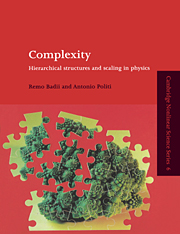Book contents
- Frontmatter
- Contents
- Preface
- Part 1 Phenomenology and models
- Part 2 Mathematical tools
- Chapter 4 Symbolic representations of physical systems
- Chapter 5 Probability, ergodic theory, and information
- Chapter 6 Thermodynamic formalism
- Part 3 Formal characterization of complexity
- Appendix 1 The Lorenz model
- Appendix 2 The horseshoe map
- Appendix 3 Mathematical definitions
- Appendix 4 Lyapunov exponents, entropy, and dimension
- Appendix 5 Forbidden words in regular languages
- References
- Index
Chapter 4 - Symbolic representations of physical systems
Published online by Cambridge University Press: 20 October 2009
- Frontmatter
- Contents
- Preface
- Part 1 Phenomenology and models
- Part 2 Mathematical tools
- Chapter 4 Symbolic representations of physical systems
- Chapter 5 Probability, ergodic theory, and information
- Chapter 6 Thermodynamic formalism
- Part 3 Formal characterization of complexity
- Appendix 1 The Lorenz model
- Appendix 2 The horseshoe map
- Appendix 3 Mathematical definitions
- Appendix 4 Lyapunov exponents, entropy, and dimension
- Appendix 5 Forbidden words in regular languages
- References
- Index
Summary
The setting of a theory of complexity is greatly facilitated if it is carried out within a discrete framework. Most physical and mathematical problems, however, find their natural formulation in the real or complex field. Since the transformation of continuous quantities into a symbolic form is much more straightforward than the converse, it is convenient to adopt a common representation for complex systems based on integer arithmetics. This choice, in fact, does not restrict the generality of the approach, as this chapter will show. Moreover, discrete patterns actually occur in relevant physical systems and in mathematical models: consider, for example, magnets, alloys, crystals, DNA chains, and cellular automata. We recall, however, that a proposal for a theory of computational complexity over the real and complex fields has been recently advanced (Blum, 1990).
The symbolic representation of continuous systems also helps to elucidate the relationship between chaotic phenomena and random processes, although it is by no means restricted to nonlinear dynamics. Indeed, von Neumann's discrete automaton (von Neumann, 1966) was introduced to model natural organisms, which are mixed, “analogue–digital” systems: the genes are discrete information units, whereas the enzymes they control function analogically. Fluid configurations of the kind reproduced in Fig. 2.2 also lend themselves to discretization: owing to the constancy of the wavelength (complexity being associated with the orientation of the subdomains), a one-dimensional cut through the pattern yields a binary signal (high-low).
- Type
- Chapter
- Information
- ComplexityHierarchical Structures and Scaling in Physics, pp. 69 - 84Publisher: Cambridge University PressPrint publication year: 1997

